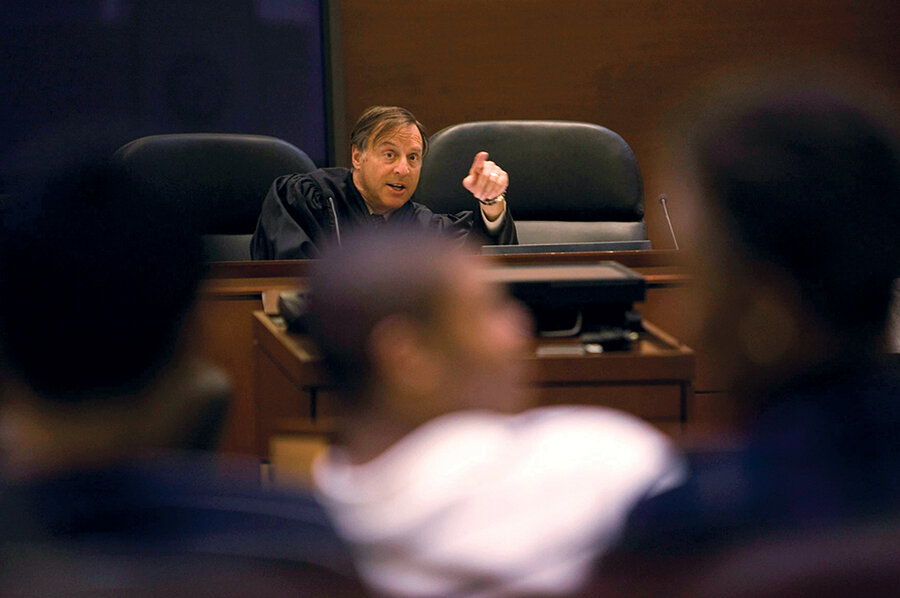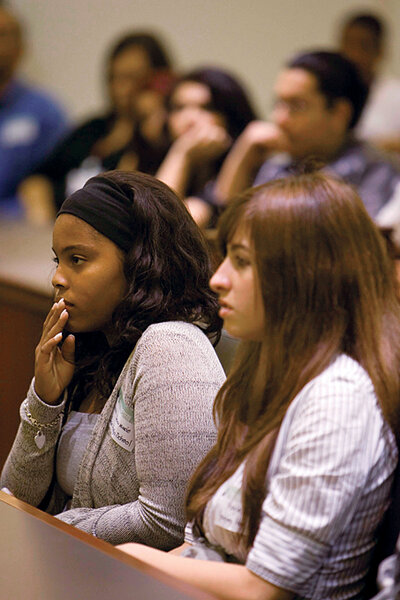Teen juries put a new spin on juvenile justice
Loading...
| Los Angeles
The 13-year-old defendant, standing before a jury of his peers, hears the verdict: guilty of battery. The teenage jury foreman then reads the punishment:
"We sentence the defendant to a daily curfew, anger counseling, and 50 hours of community service, Your Honor," he says. "Also, he is not to have any associations with gangs, will write a letter of apology to his parents and the victim, will submit to regular drug testing, and will be put on academic probation. We also will put him into regular auto shop and art classes."
Teen peer court is in session at Dorsey High School in South Los Angeles – and this is no mock trial. The defendant, Garry V., is accused of a real crime. Student jurors mete out a real sentence. Presiding Judge David Wesley is a jurist from Los Angeles Superior Court. The school's Thurgood Marshall Courtroom is complete with a judge's bench, a witness stand, a jury box, and, yes, oak paneling.
The juvenile defendants who come to this place, one of 17 peer teen courts in Los Angeles County, are facing their first criminal charges – misdemeanors such as graffiti tagging, theft, prostitution, drug possession, and battery. The intent of the juvenile justice system is to drive down the re-offense rate and keep kids out of jail; the means is a forum whereby fellow teens ask the questions, decide the case, and assess the penalty.
The thinking is that teen peers understand, better than adults, what sentences will deter delinquent behavior and what is a proper way to pay back the community or the victim.
"Using a system of peer-based judgment may have an influence on the adolescent that does not come into account when in front of adults," says Elizabeth Dowdell, associate professor of nursing at Villanova University in Pennsylvania. The possibility that adult professionals will misread a juvenile's case is eliminated, "since all of the jurors are near the same age and from similar backgrounds" as the defendants, she says. "Parents may also be involved ..., which may bring to light their teen's behaviors and their own responsibilities."
So, are teen courts any better than traditional juvenile courts at cutting the rate at which kids re-offend? Results of studies are not definitive, but they are encouraging. Comparisons of the two are difficult, researchers note, because teen courts tend to deal with lesser offenses while juvenile courts take cases of more serious crimes and repeat offenders. What's known so far is that 89 percent of the young people who were sanctioned in teen court the previous year completed their sentences, according to a 2005 study of the American Youth Policy Forum. Some even went on to serve as teen jurors themselves.
The idea is not new. Teen peer courts have been around for about 25 years and now number about 1,000 nationwide. But backers say they are ripe for further expansion – given their track record and relatively low cost. Where such courts exist, they divert about 9 percent of cases from standard juvenile court, research shows.
"Our municipal and county governments are at a critical crisis in funding," says Jack Levine, president of the National Association of Youth Courts. "We think we have developed the vaccine, which is this preventative investment in young people at the very earliest stage of their transgressions ... at school, home, or in the community."
The court at Dorsey High, where about half the students are African-American, thrives because of volunteers. They include 70 students from local law schools who advise the teen jurors about the law, community mentors who monitor defendants' compliance with the sentences, and the high school jurors, who can fulfill graduation requirements for their hours in court.
For Mr. Levine, keeping kids out of jail, where they can be exposed to more serious offenders, is key. He notes that, across America, budgets for counseling and other treatment services are being slashed or eliminated, making it harder to include crime prevention and rehabilitation in crime-fighting strategies.
Judge Wesley concurs. "The major thought behind this was the realization that you cannot lock everyone up," says Wesley, who has nearly two decades of experience starting all 17 teen courts in the county. "There have to be other ways of dealing with these children who have issues.... The hope is that we can catch them before they end up in my adult court and get sentenced to prison."
In the case of Garry V., his parents sat in the courtroom to hear questions the jurors asked of their son and to answer questions directed to them.
"Did you know your son was doing drugs?"
"Did you know he hangs out with gang members every day after school?"
The judge is there to explain the charges to defendants and jurors chosen at random from among the students who sign up to serve on the court. After charges are read, Wesley asks the defendant and the parents if they know any of the jurors – or if jurors know them – before proceeding.
"In this age of bullying, harassment, and in some cases payback – both in person and via the Internet – confidentiality would be important," notes Professor Dowdell.
Court usually convenes at 3:30 p.m. once every other week, and lasts about three hours. Three cases may be heard each session.
Education about court procedures and legal concepts is one side benefit of teen courts, say authorities.
"This has been an absolutely fabulous program," says Laura Cohen, director of a street law clinic and community outreach for Southwestern Law School, which has a pool of about 70 law students who attend peer court sessions and answer questions from high school students.
Part of the value of teen courts is that jurors can hear answers from victims, parents, and others, which are usually withheld from court proceedings, says Jo Ann Allen, director of Santa Cruz County Teen Peer Court, who has 16 years of experience with such courts.
"Sometimes the back-and-forth between jurors and parents will be so revealing it brings tears to everyone's eyes," says Ms. Allen. "No matter what the verdict, everyone goes home in a different mental space that has the quality of catharsis, something you almost never get in a real courtroom."
During the 2-1/2 years that probation officer Meado Broddie has served as teen court coordinator for the section of L.A. that includes Dorsey High, 90 percent of defendants have not reoffended. They have some incentives to succeed: They had to promise to abide by the teen peer court decision and, if they follow the judge's and the jury's orders, the case against them will be dismissed.
"The perhaps counterintuitive observation I notice from watching this is that the sentences are probably stricter and harsher than those given out at juvenile court," Ms. Broddie says.
Egypt Brown, a student on the jury in the Garry V. case, says teen court verdicts usually become deterrents to future illegal behavior.
"In this particular case, I worry that the defendant was too entrenched in his ways, that this court got to him too late to do any good," she says. "It looked like he had already made up his mind to do things he did."
Los Angeles Superior Court regularly gets requests from local schools to start new teen courts, but funding restrictions prevent it, says Camilo Cruz, community relations administrator for the court.
"Judge Wesley has done an amazing job at keeping our teen court a [volunteer-based] program," Mr. Cruz says. There is no budget, other than in-kind services donated by judges, probation officers, and administrative staff. "What we do need is much more support and/or resources for probation, which is a department spread extremely thin."






